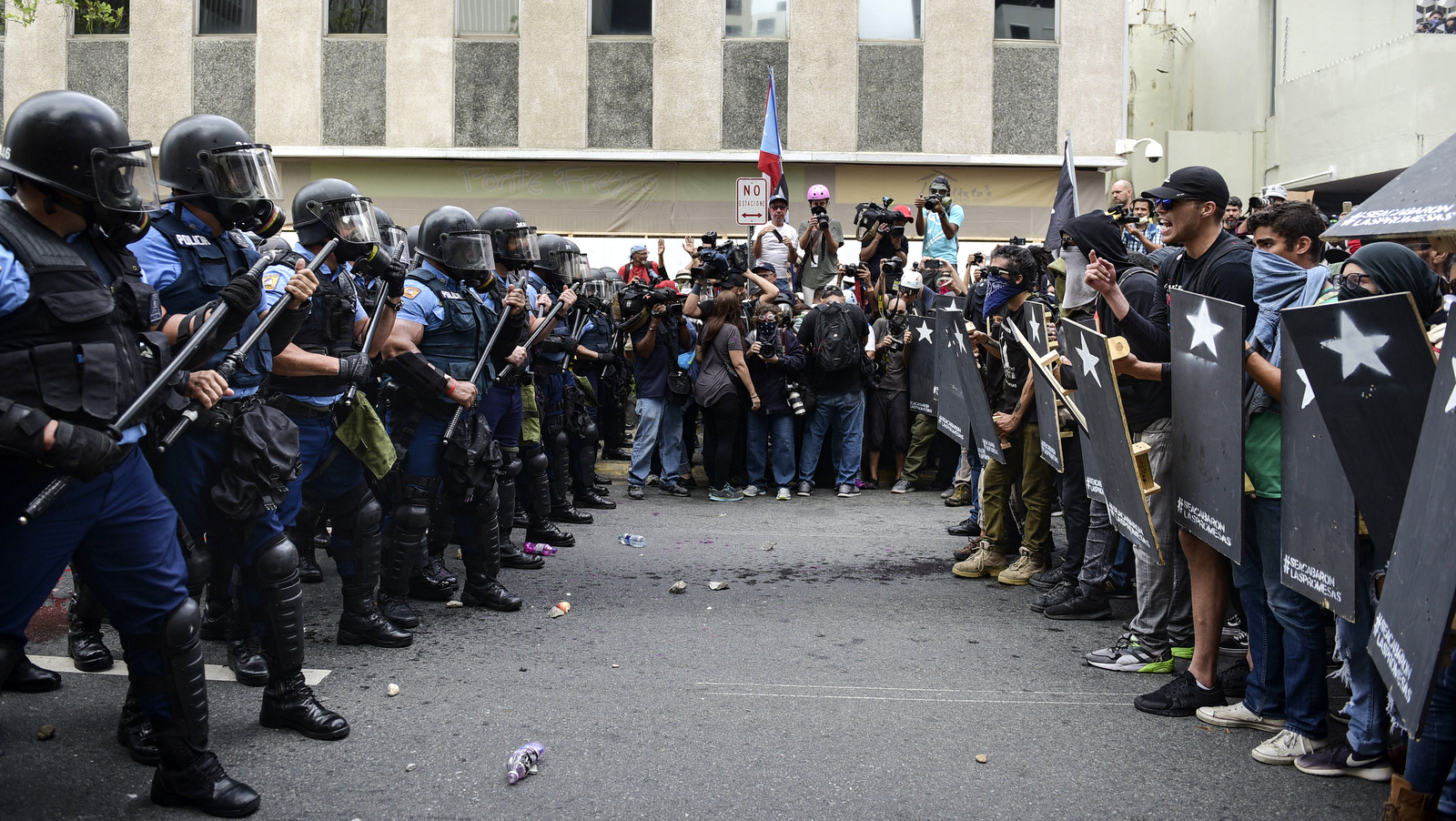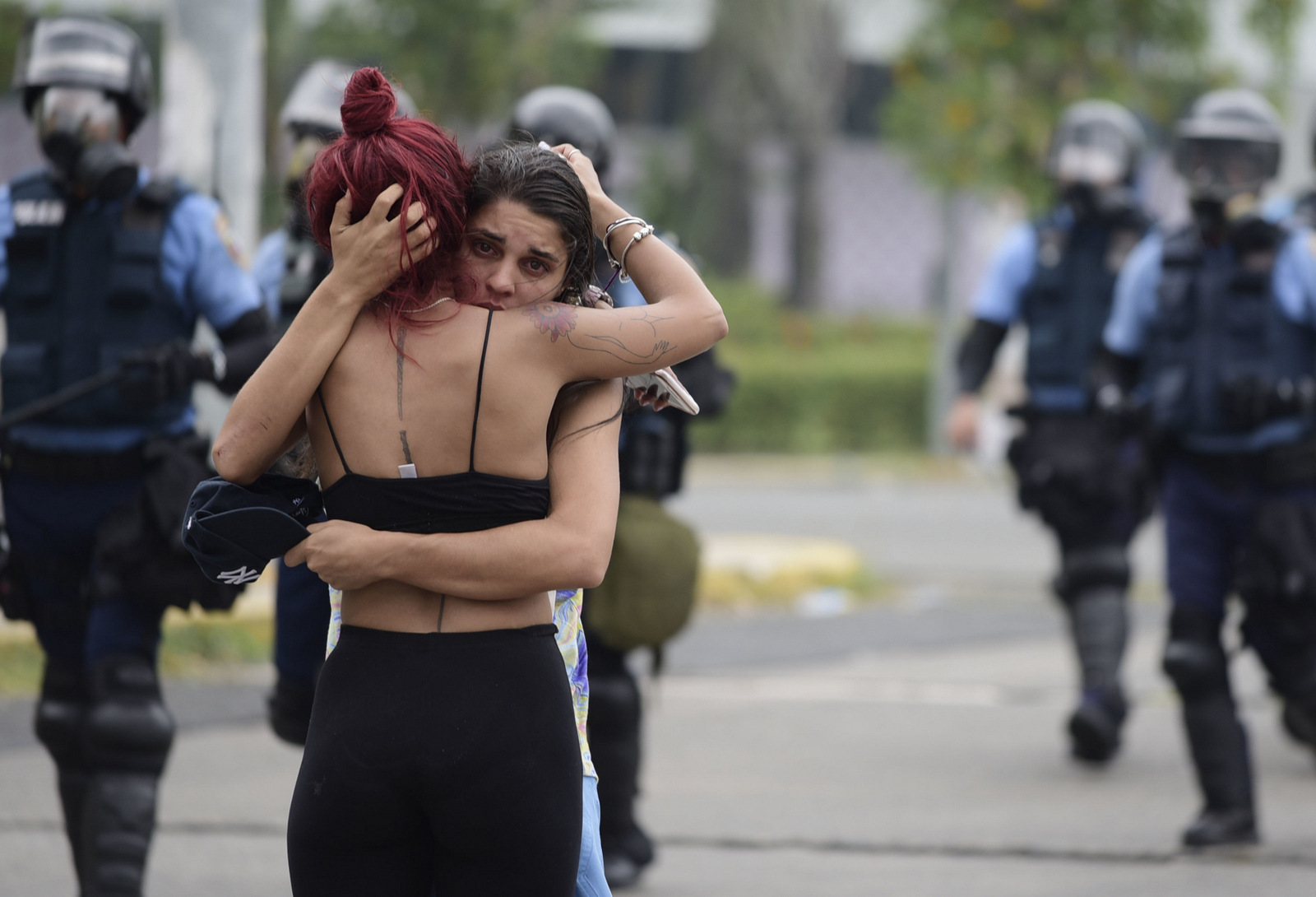SAN JUAN, PUERTO RICO — Puerto Rico’s capital was the site of massive scenes of brutal repression as police clamped down on an International Workers Day march using overwhelming violent force, scattering thousands of protesters who gathered to resist austerity measures and anti-worker attacks on the people of the U.S colonial territory.
Despite the colonial administration’s tendency to criminalize mass demonstrations, the call to launch a one-day May Day general strike enjoyed the support of Puerto Rico’s social movements, political parties, and trade unions representing hundreds of thousands of workers suffering from the combined blows of new anti-worker measures, an imposed economic crisis, and a lackadaisical federal effort to assist the disenfranchised U.S. territory after Hurricane Maria struck the island seven months ago.
Watch | Police use tear gas on Puerto Rico’s May Day protestors
Colorful waves of striking workers, wearing their organizations’ respective colors, flooded San Juan’s “Golden Mile,” or Milla de Oro, financial district to protest the ongoing attacks on their interests in an offensive that far predates the devastation wrought by last year’s hurricane.
Various marches converged in hopes to reach the final destination point: Seaborne Building, the headquarters of the Financial Oversight and Management Board (FOMB) – a Washington-appointed colonial body in charge of gutting the nation’s pension system, privatizing public schools, and imposing anti-worker labor reforms.
It was there that protesters were greeted by rows of assembled tactical police equipped with gas-masks, less-lethal weaponry, night sticks, armored vehicles and heavy crowd-control armor.
While hundreds of militant youths had split from the main routes negotiated with police in breakaway rallies, others advanced to the front of the main march in an attempt to break police lines with makeshift poles and crude projectiles such as rocks.
Police responded by launching a brutal attack against the entire demonstration, bloodying old and young marchers alike while indiscriminately showering crowds with tear-gas canisters and pepper spray.

Police and protesters face off at a May Day march in San Juan, Puerto Rico, May 1, 2018. Police fired tear gas and rubber bullets into the crowd. (AP/Carlos Giusti)
In one particularly dramatic video, dozens of police officers clad in riot gear can be seen chasing youth into residential neighborhoods and private homes, forcing youth face-first into the ground, and sealing off narrow streets while horrified residents shout curses at the officers.
Despite government claims that rowdy youth sparked the “clashes,” the Puerto Rico Teachers Federation (FMPR) condemned the police actions, stating:
[We denounce] the aggressions and arrests of young people who participated in the demonstration. It was a police provocation in which demonstrators were cornered in order to spark moves to justify the attacks by the police.”
“Abusive and criminal” attacks on public education
A leading union representing the colonized nation’s education workers, the FMPR began their May Day with a rally at the Department of Education building. Clad in yellow and denouncing the island’s colonial administration as “abusive and criminal,” FMPR educators demonstrated to resist a major “education reform” that will see the public education system privatized through the closure of nearly 300 schools, the slashing of pensions, and the imposition of charter schools.
Speaking to local newspaper El Vocero, teacher and FMPR President Mercedes Martinez Padilla described the demonstrations as a major success. In spite of the repression carried out by police, teachers and students delivered a powerful message to the state and the despised secretary of education, Julia Keleher.
Martinez noted that according to the Department of Education, over a quarter of the island’s teachers – numbering 25.8 percent of all educators in the nation, or over 8,000 teachers – had heeded the call to strike.
“Thousands marched from the Department of Education to the Golden Mile demanding, among other things, the revoking of the order to close around 280 schools,” Martinez said. She added:
The Department of Education admitted that 93.8 percent of the students did not attend classes today. This marks an indisputable success for school communities.”
Hurricane Maria’s lingering horrors
Puerto Rico had already been in dire straits prior to September 20, 2017, when Hurricane Maria began to take her grim toll on the people of the island, crippling the nation’s infrastructure, destroying entire neighborhoods, and depriving millions of food, power and water. The storm caused an estimated $100 billion in damage.
For nearly the entire preceding decade, Puerto Rico was mired in a crippling recession. Last year, the country was set upon by usurious hedge funds, known as “vulture funds,” which sued Puerto Rico’s government for defaulting on its bonds. With little support from Washington, the imposition of draconian austerity measures on the nation’s social service, education, and health care systems was ensured.
Related
- Puerto Rico: 1M Without Power 100 Days After Hurricane Maria
- Puerto Rico’s Recovery Efforts Stymied by Colonial Status
- Colonization of Land and Mind: The Struggle for a Post-Colonial Puerto Rico
- Warnings Of ‘Disaster Capitalism’ And Privatization Emerge In Puerto Rico
Beyond its debt-riddled recent history, Puerto Rico is also one of the U.S.’s last colonies. After the U.S. invaded the country during the Spanish American war in 1898, the people of the island were granted U.S. citizenship in 1917. The island, however, remains a stomping ground for U.S. corporations and the U.S. Armed Forces, which maintain significant military infrastructure across the island.
Meanwhile, the over 3 million citizens on the island are denied their basic rights to self-determination. As Hurricane Maria revealed, these U.S. citizens have also been denied basic protection by the U.S. federal government from the massive humanitarian crisis triggered by last year’s Category 5 storm.
Following the disaster, homicide rates nearly doubled while alcoholism also increased to around 50 percent of the adult population on the island. Suicide rates drastically skyrocketed as the hopeless conditions of post-disaster Puerto Rico set in, while constant blackouts and power outages plunged much of the population into a state of extreme post-traumatic stress disorder (PTSD).
According to Psychiatric Times:
With little economic relief in sight in the foreseeable future, approximately a million Puerto Ricans are expected to present with PTSD in the next two years and hundreds will die by suicide as a result of the hurricane.”
Recovery through struggle
Marked across the globe on the First of May every year, International Workers Day began on May 4, 1866 with the murderous police suppression of an industrial workers’ strike in Chicago, Illinois. The main demand of the workers — led primarily by anarchists and syndicalists — was simple: an “eight-hour day with no cut in pay.”
As police attempted to disperse a crowd of 3,000 striking workers, officers came under attack by bombs allegedly thrown by a left-wing terrorist in the crowd. Many suspected that the unidentified bomb-thrower was either a hireling or an asset manipulated by the police — an agent provocateur. Police immediately responded by firing with reckless indifference into the crowd, killing seven or eight workers and injuring dozens.

Two women embrace after a May Day march turned violent, in San Juan, Puerto Rico, May 1, 2018. (AP/Carlos Giusti)
In the immediate aftermath, 31 militant organizers — trade unionists, intellectuals, activists — were arrested, among whom eight faced a trial. Following a rigged judicial process, in which jurors were drawn from the ranks of employers, three of the eight were given prison sentences exceeding 30 years, while five organizers – including seasoned anarchists with long histories in the workers’ movement – were sent to the gallows and immortalized as the Haymarket Martyrs.
German-born anarchist newspaper editor August Spies’ final words — uttered just before the trapdoor beneath his feet opened — remain inscribed in the collective memory of the modern working-class:
The time will come when our silence will be more powerful than the voices you strangle today.”
Since then, workers’ movements in every corner of the globe have used the day as an occasion not only to mark the sacrifices of martyred working-class militants and organizers, but also to stage their own advances and celebrate the fight for improved social conditions, political rights, and dignity in the face of employer and government collusion.
It’s precisely that tradition which Puerto Rican workers honored as they took to the streets Tuesday to fight for their basic right to control their schools, their workplaces, their collective destinies and their right to live as a sovereign nation – rights threatened by U.S. lawmakers, bankers, and unelected colonial entities clamped on the island like so many leeches.
The events of May 1, 2018, testify not only to the savage nature of Puerto Rico’s neoliberal colonial administration and its “vulture” capitalist backers – but also, these events are an admirable testimony to the undying combativity of the Puerto Rican people.
Subjugated, immiserated, and impoverished, the Boricuas have little left to lose; but it’s precisely these desperate conditions that prevent them from dropping a basic urge to survive — which manifests itself now, as it has throughout the island’s colonial history, through a deeply-ingrained defiance toward the dictates of U.S. imperialism.
Top Photo | Police detain a protester after a May Day march to protest pension cuts, school closures and slow hurricane recovery efforts turned violent, in San Juan, Puerto Rico, May 1, 2018. (AP/Carlos Giusti)
Elliott Gabriel is a former staff writer for teleSUR English and a MintPress News contributor based in Quito, Ecuador. He has taken extensive part in advocacy and organizing in the pro-labor, migrant justice and police accountability movements of Southern California and the state’s Central Coast.
The post May Day Repression Reveals Savagery of U.S. Colonialism, Resilience of Puerto Rico’s People appeared first on MintPress News.
